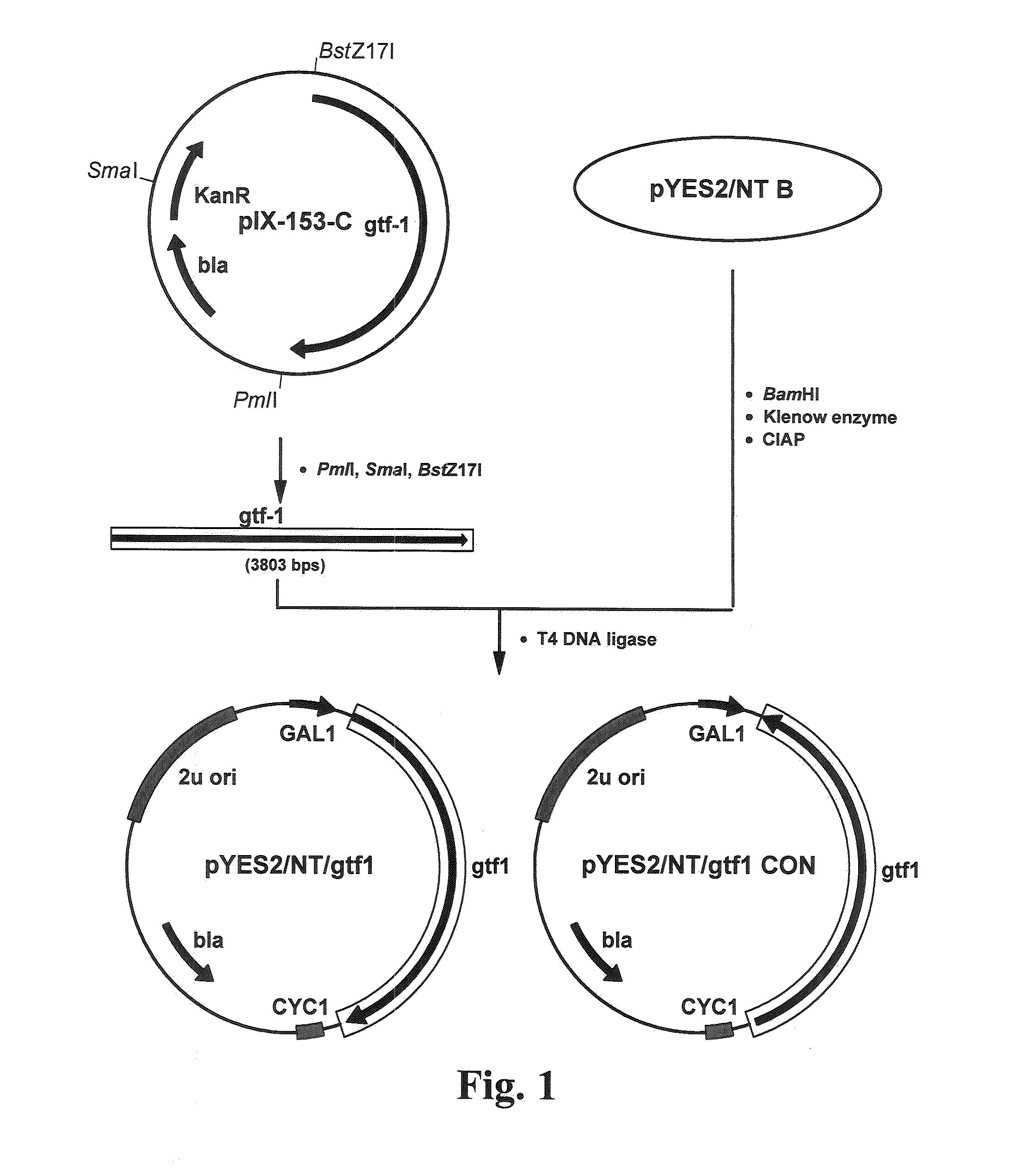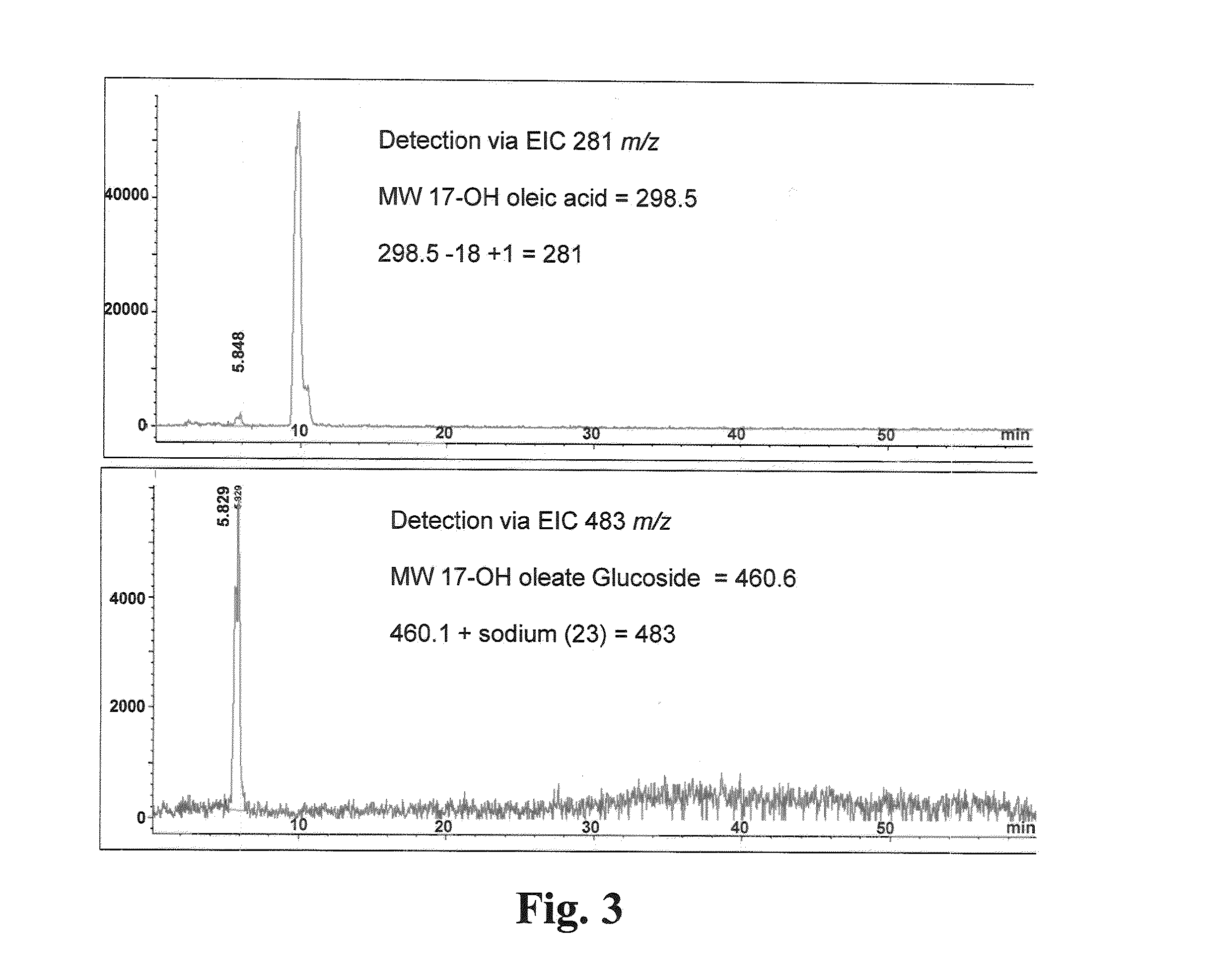Novel use of glucosyltransferase gene
a technology of glucosyltransferase and gene, applied in the direction of transferases, bulk chemical production, enzymology, etc., can solve the problems of lack of research to delineate the metabolic pathway and the genetics of sophorolipid biosynthesis
- Summary
- Abstract
- Description
- Claims
- Application Information
AI Technical Summary
Benefits of technology
Problems solved by technology
Method used
Image
Examples
example 1
Cloning of gtf-1
[0064]Candida bombicola NRRL Y-17069 is obtained from ARS Culture Collection (NCAUR, Peoria, Ill.) and Candida bombicola ATCC 22214 is obtained from ATCC (Manassas, Va.). Genomic DNA is isolated using YeaStar Genomic DNA Kit (Zymo Research, Irvine, Calif.) according to manufacturer's instructions. PCR cloning techniques described in Solaiman 2000, Biotechnol. Lett. 22:789-794 and Solaiman and Ashby, 2005, Curr. Microbiol. 50:329-333 are adopted for cloning gtf-1 from C. bombicola. Two primers, CL-V-114L1 (SEQ ID NO: 1) and CL-V-114R2 (SEQ ID NO: 2), are designed based on the conserved regions of the amino acid sequences of UDP-glucose:sterol glucosyltransferases of S. cerevisiae (gi6323218), P. pastoris (gi4768597) and C. albicans (gi4768599). The primers are purchased from Sigma Genosys (Woodlands, Tex.). PCR is performed on a GeneAmp PCR System 9700 (Applied Bio systems, Forster City, Calif.) using thermal cycling programs appropriate for the specific thermo-tolera...
example 2
Construction of Saccharomyces cerevisiae Clones for gft-1 Expression
[0067]After the entire nucleotide sequence of gtf-1 is assembled via the combined PCR and genomic DNA walking techniques detailed in Example 1, the gtf-1 gene is then amplified from C. bombicola genome using GeneAmp PCR System 9700 (Applied Biosystems, Foster City, Calif.) using thermal cycling programs appropriate for the thermo-tolerant DNA polymerase and the following primers: CL9-102F1 (5′-AAGGATATCTCTACCAATCAATTGAGGCTG-3′; SEQ ID NO: 7); CL9-102R1 (5′-ACTCCTAGGCTGGCCATGGATGTGTCTG-3′; SEQ ID NO: 8); CL9-110F2A (5′-ACGGAAGAAGGTGCGGATTC-3′ SEQ ID NO: 9); CL9-110R2A (5′-CTCGCGAATGAAAGAATAAC-3′ SEQ ID NO: 10); CL9-102F3 (5′-AGAGTTTCGAGAGATCGCTG-3′; SEQ ID NO: 11); and CL9-102R3 (5′-ACTGCGGCCGCATGATCACACTGATACGTCA-3′; SEQ ID NO: 12)) and according to manufacturer's instructions. The gtf-1 gene (3.7 kb) is amplified in sections to minimize mis-incorporation of nucleotides during the amplification process. The final am...
example 3
Quantitative RT-PCR Assay of gft-1 Expression in S. cerevisiae
[0071]The expression of gtf-1 cloned into S. cerevisiae via the yeast vector pYES2 / NT B is determined using qRT-PCR method. S. cerevisiae harboring the expression vector pYES2 / NT / lacZ is used as the negative control. S. cerevisiae INVSc1 [pYES2 / NT / gft1] and INVSc1 [pYES2 / NT / lacZ] are streaked on SC-U+Glu(2%) agar solid-medium plates and grown for 2 days at 30° C. Individual colonies are picked to inoculate 15 ml of SC-U+Raf(2%) which contains, per liter, Yeast Drop-Out Minus Uracil (2 g; Sigma-Aldrich, St. Louis, Mo.), Yeast Nitrogen Base Without Amino Acids (6.7 g; Sigma-Aldrich, St. Louis, Mo.) and D-(+)-raffinose (20 g; Fluka (Sigma-Aldrich, St. Louis, Mo.)) in 50 ml Erlenmeyer flasks. One set of cultures are grown 18-20 hours at 30° C. and 200 rpm, and 1-ml of these overnight (i.e., grown for ≧16 hours) cultures are further used to inoculate another set of similar medium. The two sets of cultures are returned to the ...
PUM
| Property | Measurement | Unit |
|---|---|---|
| Fraction | aaaaa | aaaaa |
Abstract
Description
Claims
Application Information
 Login to View More
Login to View More - R&D Engineer
- R&D Manager
- IP Professional
- Industry Leading Data Capabilities
- Powerful AI technology
- Patent DNA Extraction
Browse by: Latest US Patents, China's latest patents, Technical Efficacy Thesaurus, Application Domain, Technology Topic, Popular Technical Reports.
© 2024 PatSnap. All rights reserved.Legal|Privacy policy|Modern Slavery Act Transparency Statement|Sitemap|About US| Contact US: help@patsnap.com










